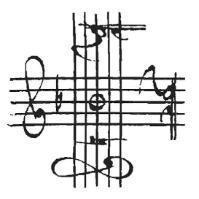Leaderboard
Popular Content
Showing content with the highest reputation on 05/22/2020 in all areas
-
1 point
-
1 point
-
Wow, this is very good in terms of technical aspects, the two voices are very well connected in my opinion, the whole music makes sense within it. I just cant figure out exactly what is this style, I see a bit of tchaikovsky maybe and russian romantic music overrall? I liked a lot congrats1 point
-
Just a simple piano theme I've been experimenting with. Wanted to capture the theme of Passion with some Fury.1 point
-
Here my new piece for SATB and Organ. I love singing and religious music, so I decided to write that. Hopelly I can perform it life one day 🙂 Lyrics are not mine, it's and old christian song dedicated to the Virgin Mary, that many composers from the renaissance and later on used in their works. Orlandus Lassus, Palestrina, Michael and Joseph Haydn among many others have compositions on that lyrics. The structure is AB (x2) - C (x2) A and B are 8bar phases with a half cadence in the middle and a perfect cadence at the end. C is a non-regular 7bar phrase ending with a perfect cadence. Here the lyrics with translation: I appreciate your comments. --------------------------------------------------------------------------------------------------------------------- Ave, Regina caelorum, Ave, Domina Angelorum: Salve, radix, salve, porta Ex qua mundo lux est orta: Gaude, Virgo gloriosa, Super omnes speciosa, Vale, o valde decora, Et pro nobis Christum exora. Hail, O Queen of Heaven. Hail, O Lady of Angels Hail! thou root, hail! thou gate From whom unto the world a light has arisen: Rejoice, O glorious Virgin, Lovely beyond all others, Farewell, most beautiful maiden, And pray for us to Christ.1 point
-
1 point
-
Thought epic music it's not my composition style, I think the opening is nicely constructed: you start with a soft sustein harmony, then add some movement with the piano, than a cello ostinato and finally the drums. The technick of adding layers works perfectly here. The chorus doubled by winds are also nice, it's indeed epic and cinematic. You could perfectly leave the piece like that. And of course, you could enlarge that in many different ways...it depends on your purpose. You have nicely built up the piece (from - to +), you can try to reverse the proccess going smoothly from + to - and finish there, or even add a short big climax after the decrescendo. You can experiment changing the octave of the celli ostinato to the violins and changing the octave of the melody and present it with a different orchestration. you can also present the main theme with just a pizzicato arpeggio on Celli or DB and some soft sustain notes below or above the melody. You can reinforce the rythm with a rythmic accompaniment on low brass (horns, trombone or tuba) like the one on the screenshot. You can make some variations on the theme itself...there are plenty of ways. That are just ideas you experiment with and see which ones you like and find the appropiete moment to use them, but I think most of the work is done...I hope it helps. I could tell you more if I see the score 🙂 With the tittle I can not help you, I have problems miself to find tittle to my works. One question: that instruments are you using at the beginning? its just voices or also muted strings or organ? It's hard to say without score...1 point
-
Good work and nice piece. Just some observations: I'm not very fond of repetitions. There are parts where the first part is repeated with addition of a second voice and that's OK, but before that, there is too much repetition (with no variation) for me. I know that's the style, although it's not clear what style is this: classical + romantic. Yes, there is no transitions for the A maj part. Also, I think the "cadenza andaluza" (which is beautiful) doesn't fit here very well. I can handle with all that, but one thing I often see is taking a pattern for the left hand and fix it "forever". Man, that's an "easy solution". A more than 6 min piece with that feature is quite rare to see. In the romantic period arpeggios are used for sections (usually they change with other sections) but the melody in romanticism is much more rich and ornamented. I would have written this in 12/8.1 point
-
As always, a beautiful piece! ☺️ I loved the proportion, the repetition, to me it sounded perfect!1 point
-
1 point
-
mm. 13-14's a/t interaction stands out to me. Maybe the voice crossing, the insistence of a dissonant passing tone or the direct fifth the tenor makes with the soprano (which isn't a rule-based problem), but something about the area still feels off to me. Simple, but pleasant otherwise.1 point
-
Here my Dies Irae from my little Requiem I'm writing. Latin text: Dies iræ, dies illa, Solvet sæclum in favilla, Teste David cum Sibylla! Quantus tremor est futurus, quando iudex est venturus, cuncta stricte discussurus! English traduction: Day of wrath, that day in wich the centuries are reduced to ashes; as witnesses King David and the Sibyl! How much terror there will be, when the judge is about to come, to judge everything strictly! Happy for feedback! Soon I will upload the score but here is the audio:1 point
-
The Emperor Sonata for Two Pianos is he 14th sonata I wrote for piano (even though the 1st for two pianos). I consider this sonata my 1st sonata (because the other 13 before this one could fall into the "Sonatina" cathegory.). The idea with this piece was inspired by the concept of Liszt's Sonata in B flat minor of creating an enourmous sonata where all the sonata is a gigantic sonata form. The first movement introduces the first subject (the Prometheus Theme by Beethoven). Second movement he second subject. Finally the third would be a third subject and the development . The cadenza its the recapitulation where all the subjects are restated in the same key and are transformed into this kind of "Fugue" where all the subjects sound toghether in harmony. The sonata is inspired in the 5th symphony of Beethoven, the first movement starts in C minor and the last in the glorious C mayor. During most of the piece the doted rythim can be heard. That rythim is for simulating a horse running. MOVEMENT I (Allegro) The first movement is written in sonata form. The first subject is introduced in C minor (1:28 min), the second subject (the Prometheus Theme by Beethoven) is presented in G mayor (2:20 min). The movement stills need to be finished (a lot) Ingnore from minute 3 until the end. MOVEMENT II (Adagio) The second movement is written in G mayor, (it needs to be transposed to D mayor so the theme in the second movement is in the dominant of the Prometheus Theme). The movement is still very raw. Its still needs to be developed and polished. In 4:13 min, the arpeggios of the first movement reapear. MOVEMENT III (Alegro Maestoso) The third movement, the finale, presents the last subject (that is just a baseline for the ending "fugue"). Then it develops the baseline and repeats it again. When the coda starts (5:48 min), there is where I need to work. In that part the "fugue" will enter (6:04 min).1 point
-
I hope you all are doing well this days! Here I share a little scherzo of a little symphony I'm writing to practice. The scherzo is based in some fragmented themes my little sister was tackling on the piano (that is why she is mentioned in the score!) I hpe you enjoy it and as always I'm open for feedback and things to improve. I know that the structure of the scherzo it is not completly correct as in the scherzo part I do not repeat the A section and then the B section. Aswell istead of a trio there is some sort of funeral music (to give some contrast).1 point
-
@DanJTitchener, @Tortualex Thanks for the advice, even though now I've set aside this project, I just needed this type of advice so when I come back woring on it I can modidify with some ideas in my head. I'll try to to take in account all the points you've mentioned. I think I'll be able to take in account almost everything because I aswell was not very satisfied with the direction It was going (That is why I posted here 😃 ) so thanks a lot for spendig some time giving some feedback!1 point
-
Here the first 47 bars of the first movement of my first symphony! Allegro.mp3 Open for feedback and suggestions!1 point
-
1 point
-
Here the still unfinished introtius of my requiem. The opening is inspired by the Requiem in C minor of Haydn. I would appreciate feedback! 🙂1 point
-
Thanks for your comment! Yeah, I as well think there is to much doubling not giving the pice a more diverse texture. I'll try to add more harmony and take away some instruments. Thanks again for your feedback! 🙂 Yes there is, but right now I'm a bit ashamed of my orchestration skills 😅!! Maybe some day I will... Thanks @Tónskáld for your comment!!!1 point






